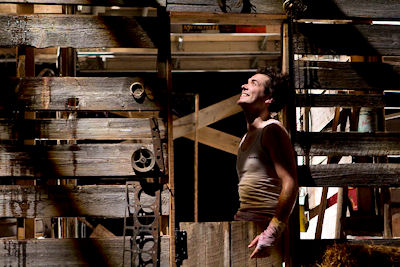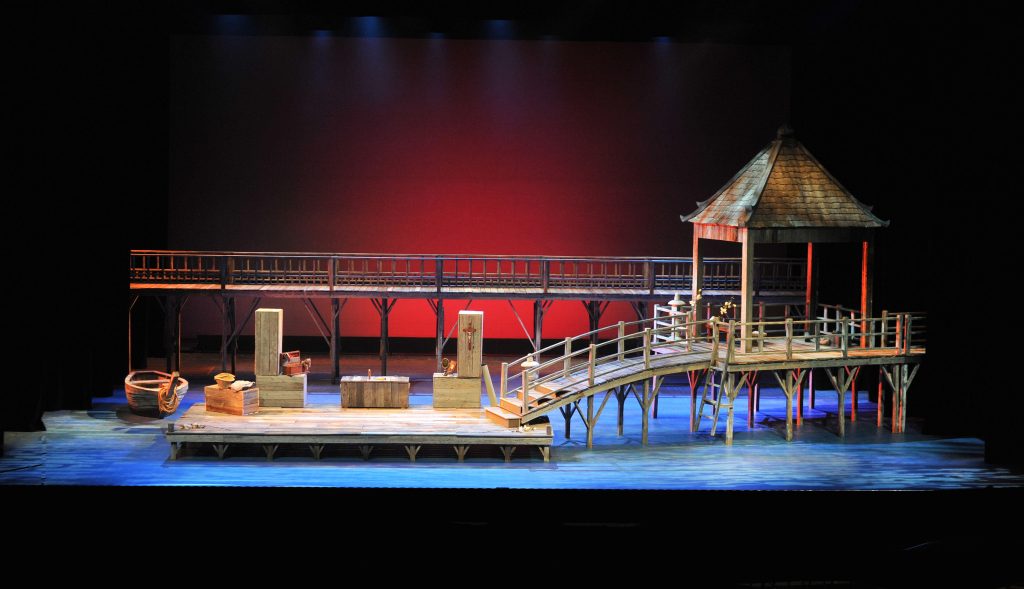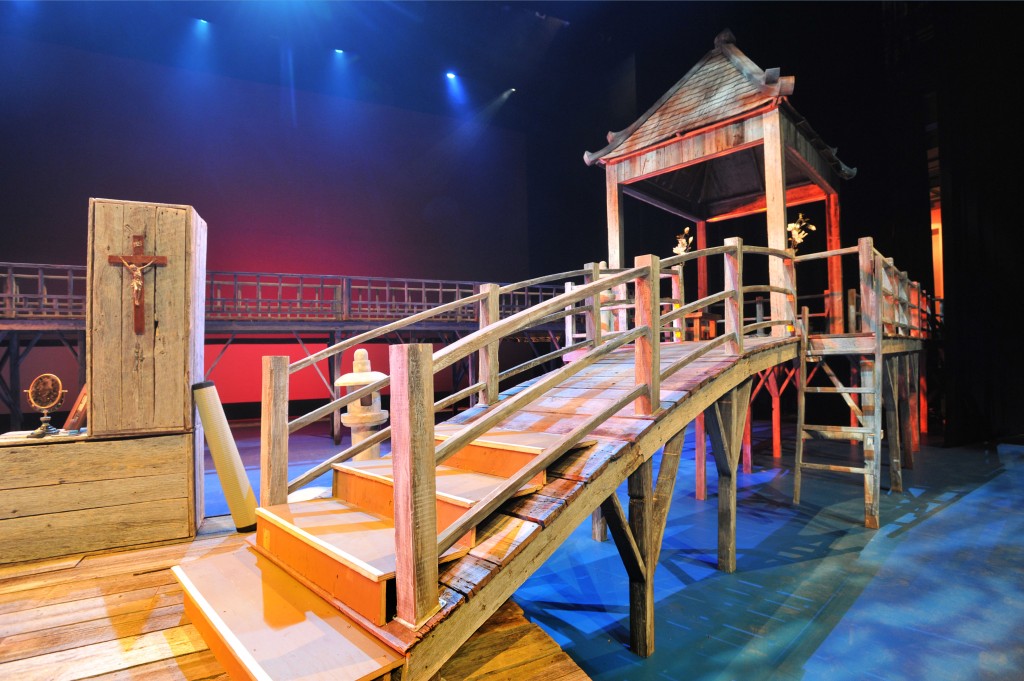Marie-Renée Bourget Harvey is French-Canadian scenographer who is passionate about integrating sustainability and poetry at the heart of her artistic approach. She seeks to erase the boundaries between her personal and professional values to create an impactful and necessary reconciliation. The more she advances in this process, the more she realizes that all our actions, however small they may be, have an impact on the community, on everything. Instead of denying these ties, she now seeks to forge them.

How did your interest in Ecoscenography and sustainable theatre production begin?
My passion for sustainability has been there from the very beginning of my theatrical journey (over 15 years). When I first started out in the theatre, we worked in very small teams and did everything ourselves, so nothing was thrown away unnecessarily. It was only recently that I realised how sustainability has always been at the heart of my artistic approach. I was always the ‘annoying one’ on productions – the person who ensured and insisted that nothing be thrown away!
It took Jasmine Catudal (who organized the Quebec exhibition And after at the Prague Quadrennial in 2019) to alert me to my sustainability ethic and insist that I be part of the delegation of artists at PQ. Previously, I had been inclined to keep quiet about my sustainability concerns and put all the responsibility of Ecoscenography on my shoulders.
Now, I am grateful and so full of joy to work with Anne-Catherine Lebeau (Écosceno) to share my sustainability journey with others.
What does Ecoscenography mean to you? How do you define it (for yourself and others)?
Love. Really! For me, eco-design means to love and take care of others, the planet and myself. It is the main inspiration that drives me and challenges me in infinite ways. And the more ‘I love’, the more it becomes a natural part of who I am, not just as a concept, but also as part of my reality. This changes everything because nothing is external to me anymore, and I am no longer separated from my personal and professional values. Love is a powerful tool that keeps me thriving. My passion also comes with an infinite dose of hope that allows me to move forward and continue wanting to do and see things differently.
When I define eco-design to others, I describe it as a process of creation that adds meaning to our artistic voice. We must take the time to think about the community and inject meaning into our decisions. We must make sure that we respect all matter as well as human beings – to love them, to take care of them, to allow them to regenerate. It is respecting all that is. Eco-design is a way for me to create a healthy environment right now and for the generations that will follow. It is also, and above all, a commitment to perpetuate life. And it is extremely motivating to choose this commitment.

Can you tell me about your work on La forêt?
La forêt consisted of a labyrinth of trees where more than 20 actors and musicians came to life under the theme of disillusioned tales. It was set in an underutilised site in the city, a vacant lot between two streets, under highway ramps. For this project we used security barriers (rented) and covered them with branches recovered from the pruning and ecocentres of the city. We also rented a tent to house the musicians and actors. The vast majority of the accessories and costumes were created from rental and second-hand purchases. The pennants were made from used sheets and have been reused several times since on other projects. The wigs were customized and were subsequently given to Drag Queens for their own performances. All tree branches were gently removed and shredded to create compost. To my delight, during the 4 weeks that the scenery was set, the birds came to settle in the temporary forest. I admit that I was very happy to see the city planting trees on this site the following year.


Can you tell me about your work on Tom à la ferme?
For this project, the director and I had a strong desire to represent the rural universe of the play realistically but with a poetic touch. In Quebec there are many barns with weathered timber – a look that is part of our rural landscape. Many barns are dismantled, and the wood is sold for its rustic appeal. I took advantage of this opportunity and purchased the reclaimed timber boards and then worked with the carpenter to build directly on the site to minimise excess waste.
The structure of the barn for the show was made solely from rented scaffolding structures. A good part of the house, which opened at the end of the room, was also structured in the same way. All the accessories were bought from antique dealers or borrowed from a family barn belonging to the parents of one of the actors. All the artefacts were returned at the end of the piece. I also donated the barn wood or antiques via social media. The ground was covered with soil that was recovered and donated at the end of the last show.
It was fascinating to see how the use of recycled material can create a visual and artistic richness; the passage of time gives it a complex beauty.


Can you tell me about your work on Madame butterfly?
This project was also created with weathered timber (recycled barn wood). For this design, we proposed to those who had sold us the wood to come and collect it at the end of the production. They accepted with joy! They were even surprised by the offer as this meant that the company could resell the wood and increase their profit on the same material. We also offered them all the wood they wanted from the decorated structure. Thus, a greater percentage of wood was recycled. This project proved that people are often more open than we think! Furthermore, my whole approach shows me that one of the reasons why I love creating so much is because it allows me to make surprising encounters than more ‘traditional’ ways of doing things. Every project, every subject, every way of seeing things differently allows me to make encounters that enrich my life.


In my conceptualisation of Ecoscenography I am interested in how ideas of co-creation, celebration and circulation can be considered as a fundamental part of the design process. ‘Co-creation’ implies ways of using local, serendipitous, place-based solutions in the making of the work; ‘Celebration’ is about using the stage as a platform to showcase sustainability and test out new ideas; and ‘Circulation’ is about taking the afterlife of theatre materials and ideas into consideration. Can you highlight any examples of your work that address these stages in interesting ways?
Co-creation: I am completely animated by the concept of co-creation and involving the use of local materials. Creating from what exists around us, to design an aesthetic with a local signature pleases me greatly! I believe it is possible to create this by remaining and curious.
Celebration: Up until now I have tried to prove that we can create eco-responsible scenographies without drawing attention to its sustainability credentials. Now, I am more interested in highlighting the ecological implications of a show with its audiences. I truly believe that the whole theatre community must be part of the solution. Creating for and with the wider community is a very rewarding path from all points of view.
Circulation: I am really animated by the idea of making matter circulate – to allow it to become something else, to have several lives and possibilities. This is something I take into account from the very beginning of the creative process – thinking about other ephemeral uses, but more often than not, I think about sustainable alternatives to facilitate reemployment. The truth is, I’m a matter lover. I find it moving to see materials circulate and engage with several audiences – to bring meaning into more opportunities.
What have been some of the biggest hurdles that you have encountered in implementing Ecoscenography? What are you most proud of?
I think one of the biggest obstacles I have faced is the lack of time. The conditions of creation are so short and intense that it is often lack of time that causes unsustainable practices to persist as eco-design (at least at the moment) invariably takes more time. I am truly aware that our system is not sustainable and that aiming for productivity, speed and the desire for tailor-made spectacular designs at all costs encourages over-consumption and over-exploitation of both human and global resources. I hope that in the near future, the methods of creation will change and that time will play in our favour instead of being perceived as our enemy.
In these unprecedented times (when the cultural environment is in hiatus), many people no longer want to work a senseless number of hours with unhealthy pressure and speed. Many of my colleagues are going back to school or changing jobs because the insecurity that existed before is now tenfold. When the cultural system resumes, will we refuse the old methods of operation, or will we fall back into our old habits for fear of losing contracts or of being perceived as disruptive agents? I sincerely hope that we will dare to speak and stand up to protect what we hold dear and what we care about and help create a healthier environment.
Another major obstacle that I have encountered is the lack of education and/or openness of some people who do not wish to make the effort to change their working methods. When I hear the phrase, “We’ve always done it this way…”, I sometimes rage inwardly or feel a burst of frustration. I understand that questioning our unsustainable methods requires reflection, time (and yes, again that!) and energy, but stagnating and believing that we always do the right thing – without questioning ourselves – also takes a lot of energy and removes some much needed flavour to life! I find it stimulating to question myself, to seek what is healthiest, to be alive!
What tips would you give to a scenographer who is exploring sustainable practice for the first time?
- Do not take the entire fate of the universe on your shoulders because guilt or burden is not sustainable in the long run. It is healthy and realistic to share this responsibility. It also allows us to realize that this is both an individual and collective process.
- Find some fellow eco allies! They will help to exchange experiences, to alleviate the pressure, and to see the whole picture from other perspectives. This will make finding solutions easier.
- Accept the fact that you are always imperfect, that we are all imperfect and and that’s okay. Sometimes you win, sometimes you learn, it’s pretty fair actually. Mistakes are part of the process and make it possible to learn very quickly – remember them!
- Be patient with yourself and the others, but not too much! Remain action-orientated (not too much in your head) and be curious and open.
What do you think the future of theatre will look like for a climate-resilient world?
I hope to see a more holistic way of creating by allowing people to realise themselves both personally and collectively. I believe the solution lies there. Creating for the service of the community brings such great meaning, greater than oneself. This motivates and nourishes. I hope that the notion of waste will no longer exist, and that everything will be considered as resources, therefore upgraded and loved again and again. I hope that governments will quickly prioritize the common good and put forward policies that accelerate the circular economy and make the linear economy obsolete or even illegal.
I also hope that this approach will soon be embraced by all disciplines in the industry, not just designers because I think that’s where the solution lies. Let the designers adopt this creative process, but let them be joined by the directors, technical and production directors, the workshops, the actors, all disciplines. I sincerely believe that this is the only way it will change in a global way, that responsibility and pride will be shared. And I dare to believe that we are already on this path and that everyday more people are joining it.
What is your next project?
Currently, almost all theatres or museum projects are cancelled, postponed or virtual and especially in stand-by since last March. I am very grateful because the projects that come to me are meaningful, bigger than me.
Anne-Catherine Lebeau (Ecosceno) and I are preparing training sessions in ecodesign and ecoresponsibility for the museum and cultural community that will be held in the winter and spring of 2021. I find it extremely inspiring to see the enthusiasm for these training sessions. It fills me with much hope to see that this is starting to become a main concern, that people are finally wanting to change their way of creating.

Incendies, Théâtre du Trident 2018. Director: Marie-Josée Bastien. Light: Sonoyo Nishikawa Costume: Sébastien Dionne. Pictured: Gabriel Fournier. Photo: Stéphane Bourgeois.

One thought